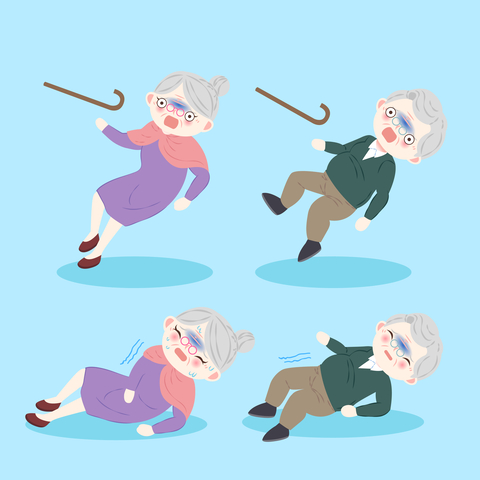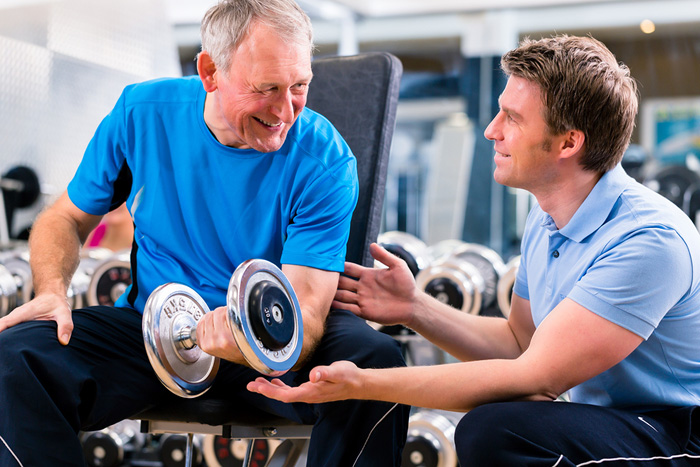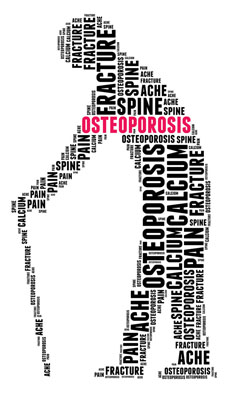Sarcopenia
 The old adage, "Use it or lose it," applies to sarcopenia
The old adage, "Use it or lose it," applies to sarcopeniaSarcopenia begins as early as age 40. Unless it is addressed, it worsens with age so that you will lose as much as one-half of your muscle mass by the age of 70.
Is your grip strength or ability to stand up from a seated position becoming increasingly difficult as you get older? Is your walking speed slower than it used to be? These are known indicators of sarcopenia.
If you want to maintain physical function and independence
as you age, this article is perfect for you. It's important because, although sarcopenia
affects 13% of people in their 60s and 50% of people in their 80s, not many
people know about it.
The good news is that no matter how old or how out of shape you are, you can restore much of the strength you have lost.
What is Sarcopenia?
The word, “sarcopenia,” literally means “poverty of flesh.” It is being defined as both a loss of skeletal muscle mass and power, and the loss of skeletal muscle function and strength. Sarcopenia is linked to chronic diseases, decreased insulin resistance, fatigue, falls, and death.

According to Dr. John E Morley, St. Louis University School
of Medicine geriatrician, “Sarcopenia is to muscles as osteoporosis is to bone,”
and it is “one of the most important causes of functional decline and loss of
independence in older adults.”
Causes include: decline in physical activity; hormonal changes; chronic illness; neuromuscular (motor neurons) changes; high levels of inflammation in the body; and lack of proper nutrition.
Frailty
The inability to develop muscle strength and power, as the result of sarcopenia, is one of the causes of frailty. Frailty, at any age, is a general condition in which a person is so weakened that any stressor can lead to a dire outcome such as: hospitalization, disability, procedural complications, and death.
Features of frailty include: fatigue; an inability to climb a flight of stairs or walk one block; the lack of ability to get up off of the floor, and being extremely underweight (skin-and-bone appearance).
How to Prevent Sarcopenia and How to Reverse It
It’s remarkable that so few people are aware of sarcopenia and its devastating consequences, especially because it is not only preventable, it can be reversed. Marilyn Moffat, PT and professor at NY University notes that research documenting the ability to reverse the losses of sarcopenia among nursing home residents in their 90s has been in the medical literature for 30 years.
“Adequate nutrition and targeted exercise remain the gold standard for therapy,” according to Dr. Jeremy D Walston, Geriatrician, John Hopkins University School of Medicine.
Strength training and sufficient protein intake are the cornerstones to preventing and reversing the losses of sarcopenia.
Strength Training
Activities such as running, walking, tennis, or bike riding aren’t enough to prevent this incremental loss of muscle mass and strength because they don’t put enough stress on the muscles. Consider the following findings.
- Dr. Maria A Fiatrone at Tufts research center reported that 8 weeks of “high-intensity resistance training” significantly enhanced the physical abilities of 9 frail nursing home residents aged 90 years and older. Strength gains averaged 174%, and walking speed improved by 48%.
- High-intensity strength training is also shown to be effective in improving bone density, muscle mass and strength in post-menopausal women.
 IF YOU ARE CURRENTLY SEDENTARY OR HAVE A SERIOUS CHRONIC DISEASE, CHECK WITH YOUR DOCTOR FIRST. THEN, TAKE A FEW LESSONS FROM A PHYSICAL THERAPIST OR CERTIFIED TRAINER.
IF YOU ARE CURRENTLY SEDENTARY OR HAVE A SERIOUS CHRONIC DISEASE, CHECK WITH YOUR DOCTOR FIRST. THEN, TAKE A FEW LESSONS FROM A PHYSICAL THERAPIST OR CERTIFIED TRAINER.
Protein
Older people absorb protein less efficiently. According to Dr. John E Morley, older people need at least 0.54 grams of protein per pound of ideal body weight. So, if you are a sedentary aging adult who should weight 150 lb, you need to eat as much as 81 grams (0.54 x 150) of protein daily.
Examples of protein content in common foods:
· 2 tbsp of peanut butter – 8 grams
· 1 cup nonfat milk – 8.8 grams
· 2 medium eggs – 11.4 grams
· One chick drumstick – 12.2 grams
· ½ cup cottage cheese – 15 grams
· 3 oz flounder – 25.5 grams
· 3 oz turkey – 26.8 grams
According to Dr. Morley, protein foods naturally rich in the amino acid, leucine, are most effective. These foods include: milk, cheese, beef, tuna, chicken, peanuts, soybeans, and eggs.
Dr. John E Morley and Theodore K Malstrom devised a simple questionnaire to screen for sarcopenia. The questions are measurements of frailty. Forty to 70% of people who are frail are also sarcopenic.
- How much difficulty do you have lifting and carrying 10 lbs?
- How much difficulty do you have walking across a room?
- How much difficulty do you have transferring from a chair or bed?
- How much difficulty do you have climbing a flight of 10 stairs:
- How many times have you fallen in the past year?
Knowledge is power when it comes to addressing sarcopenia because it can be slowed and reversed. Don't let sarcopenia destroy your quality of life.
More Topics That May Interest You
Some of the advertisers on my website are affiliate partners, which means that I may receive a small commission from any sale, at no extra cost to you.
For example, the Amazon affiliate advertising program is designed to provide a means for sites to earn fees by advertising and linking to amazon.com.
Your tips and purchases help to support this free-information website.
Thank you.
The content of this website is for informational purposes only and not intended to be taken as a replacement for professional medical advice, care, diagnosis or treatment by a doctor, dietitian, physical therapist, nutritionist or fitness instructor.
DO NOT BEGIN ANY EXERCISE PROGRAM WITHOUT CHECKING WITH YOUR DOCTOR FOR UNDERLYING CONDITIONS THAT MAY PREVENT YOU FROM DOING SO.





